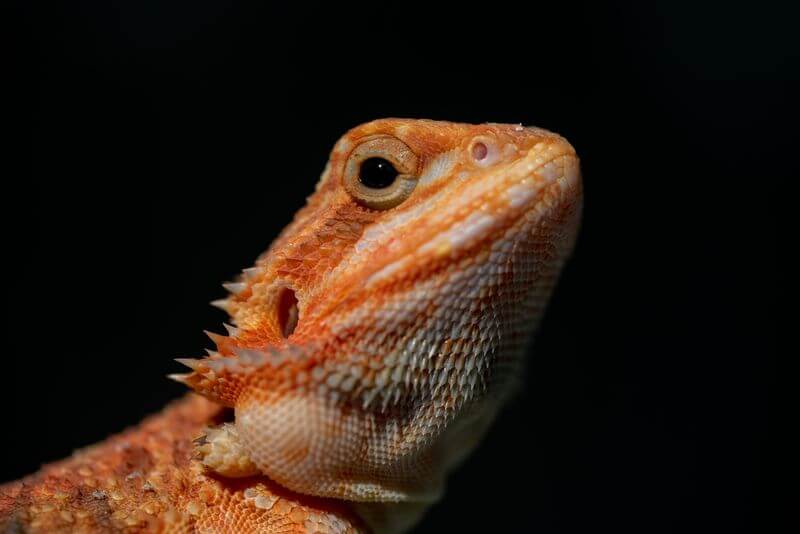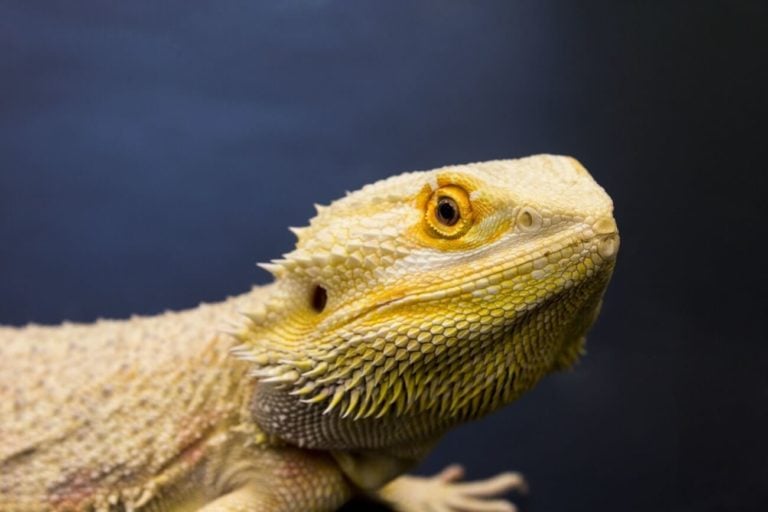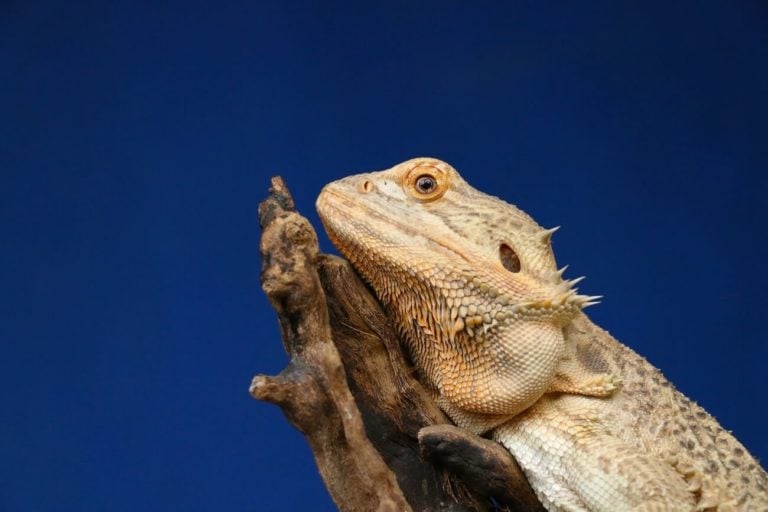Mites on bearded dragons can be incredibly frustrating for both you and your pet. But unfortunately, many owners don’t know what to do about them.
This guide will teach you how to identify bearded dragon mites, get rid of them, and keep them from coming back.
Table of Contents
What Are Bearded Dragon Mites?
Mites are a common issue that reptile owners must contend with to keep their pets healthy. These pests don’t just affect bearded dragons. They can negatively impact the health of snakes, geckos, and more.
However, mites on bearded dragons can be particularly troublesome.
Mites are tiny parasitic insects. They’re arthropods that latch onto your beardie and feed on it for sustenance. Mites are the same kinds of pests as traditional parasites like worms and intestinal protozoans. But unlike those pests, mites are external and visible to the naked eye.
You can think of them as the bearded dragon equivalent to fleas on a cat or dog.
They can cause comparable levels of discomfort, and if left untreated, they may cause severe health problems. Bearded dragon mites can carry harmful pathogens and bacteria. The risks are more than itchy scales and discomfort.
Bearded dragons can encounter mites in the wild, but those lizards have the benefit of being able to migrate to a new area. They can rid themselves of mites by shedding their skin. But with your beardie living in a confined enclosure, mites have nowhere to go.
Infections may seem minor initially, but mites can quickly proliferate in the simulated habitat, creating an ongoing problem for your lizard. Even after they shed their skin, mites can lay eggs in the tank and continue attacking your beardie.
There are many mite varieties, but there are a few that bearded dragons tend to get. These include:
- Snake mites
- Harvest mites (chiggers)
- Storage mites
Snake mites tend to attack the dark and damp parts of your lizard’s body, like skin folds, armpits, and mucous membranes. Meanwhile, chiggers aren’t so particular about where they bite. Storage mites tend to focus on the insects bearded dragons eat, resulting in the pests appearing in feces as well as on the body.
What Do They Look Like?
No matter which type of bearded dragon mite you’re dealing with, they are all small and difficult to see. You may not even notice them at first.
Early infestations are not as widespread, appearing on the body as tiny specks you might mistake as dust. It’s not until much later that most reptile owners notice them.
Either way, mites look like tiny black, red, and brown spots (or somewhere between those colors). They are about as small as a speck of pepper spice. Depending on the specific bearded dragon mite you’re dealing with, they might group in skin folds to create more visible areas of blackish-red.
You may even notice that the mites leave behind grayish dust over your beardie’s body. That color comes from the parasite’s waste!
Mites on bearded dragons can be difficult to see, but they are visible to the naked eye. That’s why paying attention to your beardie’s health is so important. These pests will also invade the enclosure, making it more paramount than ever to clean regularly (more on that later).
Causes
Bearded dragon mites can enter your lizard’s habitat in many ways. However, there are a handful of common causes to be aware of.
Purchasing An Already-Infected Bearded Dragon
Unfortunately, many mite issues begin before you even take your bearded dragon home.
Reputable breeders and sellers will go to great lengths to keep mites at bay. However, infestations can still occur.
Bearded dragon mites have a relatively short life cycle and can quickly multiply in numbers. Thanks to the proximity of animals to feed on at a pet store, they can spread like wildfire!
Before you purchase a bearded dragon, do your research about the seller or pet store. It’s also wise to do a physical inspection and take steps to ensure you’re not bringing any unwanted parasites home.
Once they enter your home, mites can invade the enclosure and anything around it. That includes your carpets, clothes, blankets, and more. While they won’t bite you, the mites eventually make their way to the enclosure to attack your beardie.
Handling Infested Reptiles
Another common cause of mites on bearded dragons is through handling. It doesn’t matter if your bearded dragon is mite-free at home. If you handle another reptile with mites, you are at risk of spreading them.
You may come into contact with infested reptiles while visiting a friend, interacting with animals at a pet store, or visiting a herpetoculture expo.
Bearded dragon mites are skilled hitchhikers. They can get onto your clothes, in your hair, onto your belongings, and more. You likely won’t notice when a few mites cling to your shirt.
But once you get home, it’s game time for the mites! They’ll quickly multiply and cause issues for your bearded dragon.
Adding Infested Supplies And Decor
You may also bring mites into your home through infested supplies. Whether you buy brand-new or second-hand, mites can hide in lighting rigs, caves, plants, and anything else you use to make your bearded dragon’s life more comfortable.
Expert Tip: If an item is not sealed, there’s always a risk. That’s why you must disinfect everything you put in or near your beardie’s enclosure.
It’s a good idea to soak dishes and decorative items with diluted bleach (and then rinse them thoroughly). You can also use pet-safe disinfectant to clean every product you buy.
Poor Husbandry
Finally, mites on bearded dragons can be a product of poor husbandry. With regular cleaning, they are easy to avoid. Even if you accidentally bring some into your home, sticking to a cleaning schedule can eliminate them without realizing they’re there.
But when you slack off and skip cleanings, mite populations can flourish. Mature mites will lay eggs in the undisturbed dark corners of the enclosure, resulting in widespread mite issues as they turn to your beardie as a new host.
Symptoms Of Bearded Dragon Mites
Bearded dragon mites are so tiny that most owners fail to realize an infestation is happening. Fortunately, there are many telltale signs that point to mite problems.
If you see any of these symptoms, it’s time to take action.
Visible Mites
Of course, the most obvious sign is physically seeing mites on your bearded dragon or its enclosure.
Mites look like specks of pepper and may be more visible when they accumulate in sensitive spots on your lizard. Pay close attention to parts of the body that are dark and damp.
In most cases, mites focus on the forward parts of the body. They tend to stick to the head and face. Depending on the type of mite you’re dealing with, they might hide under skin folds like the armpits and beard.
You may also see mites gather near the vent, between the fingers, and more. Also, look closely at the eyes. Mites like to attack where scales are thinner and easier to get around.
As a result, they sometimes attack the tissue under the eyes, resulting in noticeable redness and/or closed eyes.
Dull Or Discolored Skin
Skin discoloration is common when mites are a problem. The skin gets dull, and your bearded dragon may appear covered in a fine gray powder. Crustiness is also expected as the mites bite your lizard repeatedly.
Some mite species cause the skin to turn yellow. Either way, a sudden change in skin quality is always a red flag.
Bite Marks & Injuries
Keep an eye out for hemorrhages. While mites are tiny enough to make bites discrete, a swarm of these parasites can cause physical injuries.
You might see what looks like abrasive injuries on specific parts of the body. The eyes can turn red and sunken. Meanwhile, the skin under the arms and in skin folds can become red and sensitive.
Those signs point to mite damage.
Behavioral Changes
Minor infestations are nothing more than a nuisance for bearded dragons. But once the population grows, it starts to affect your lizard’s health.
These parasites latch onto your bearded dragon’s skin, feeding on them and draining them of their health. It’s a painful experience that will affect your lizard’s behavior.
Many will grow lethargic as they play host to a swarm of mites. Appetite changes are common, too. As the infestation progresses, you might notice your beardie lose weight, spend more time hiding, and struggle with shedding.
Itching & Scratching
Mites often result in general discomfort and ongoing itchiness. Bearded dragons will try to alleviate those issues themselves through intense scratching. Your beardie may start to rub itself on rough objects in an attempt to get relief, resulting in scratches and abrasive damage.
How To Get Rid Of Mites On Bearded Dragons
Getting rid of mites on bearded dragons is more than a one-step process. It can be tricky, but it’s manageable with the proper knowledge.
The first step is eliminating the mites from your bearded dragon’s body. There are a few different ways to do that. You can soak your lizard in warm water.
Add a drop of dish soap to weaken the parasite’s exoskeleton, and they will quickly die. However, this method can be problematic with bearded dragons because they’re not keen on deep soaks.
The best thing you can do is seek veterinary help. Vets can prescribe mite-killing medications. They work exceptionally well and are easy to apply.
The medicine usually comes in liquid form. Follow the directions from your vet to dilute it properly. That usually involves mixing a few drops in clean, distilled water. Once prepared, you can mist your bearded dragon to kill the mites on the spot.
But your job isn’t over just yet. You must also rid the enclosure and your home of mites.
Start by cleaning your home and paying extra attention to the room with your bearded dragon enclosure. Vacuum every surface, use pet-safe mite killers, and disinfect nearby surfaces to ensure that mites outside the habitat don’t cause another infestation.
Then, move on to the enclosure. Toss replaceable items like the substrate and climbing. You can replace those objects later with something newer and cleaner.
For decorative items, sanitization is vital. Use diluted bleach or a reptile-safe disinfectant to clean every item. Apply the disinfectant to the glass sides of your enclosure to make every surface spotless.
Prevention makes all the difference with bearded dragon mites. Stick to a regular cleaning schedule and disinfect surfaces often. Mites become a problem when they have time to flourish in unhygienic conditions. Being vigilant about cleanliness can keep mites out.
Consider talking to your vet about mite-preventative products, too. There are some tremendous reptile-safe solutions you can apply to the enclosure regularly to ensure that no future problems occur.
Conclusion
Bearded dragon mites don’t have to torment you and your pet. As long as you follow the recommendations above, you should have no trouble getting rid of them and keeping your beardie happy and healthy.
But as always, let us know if you have any questions. We’re always happy to help!



